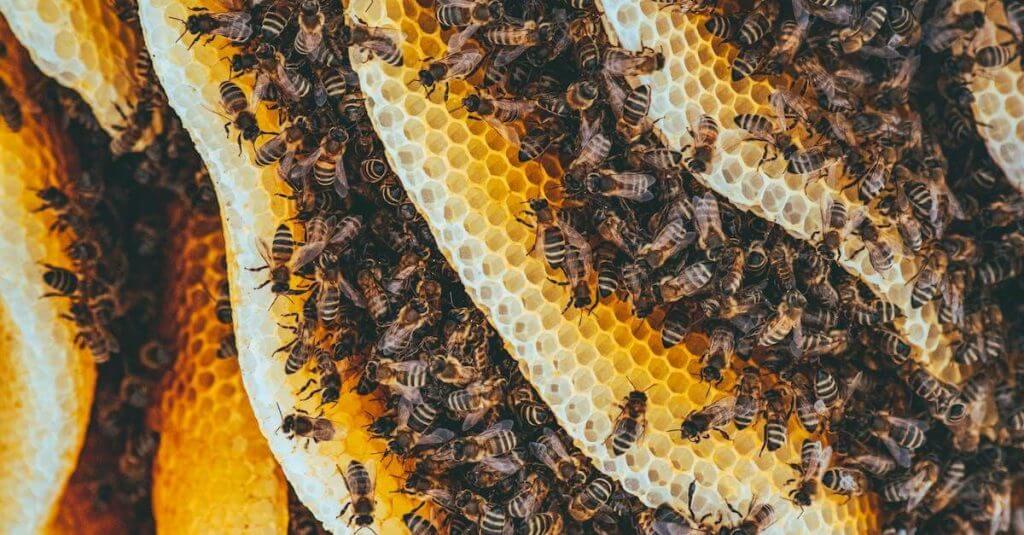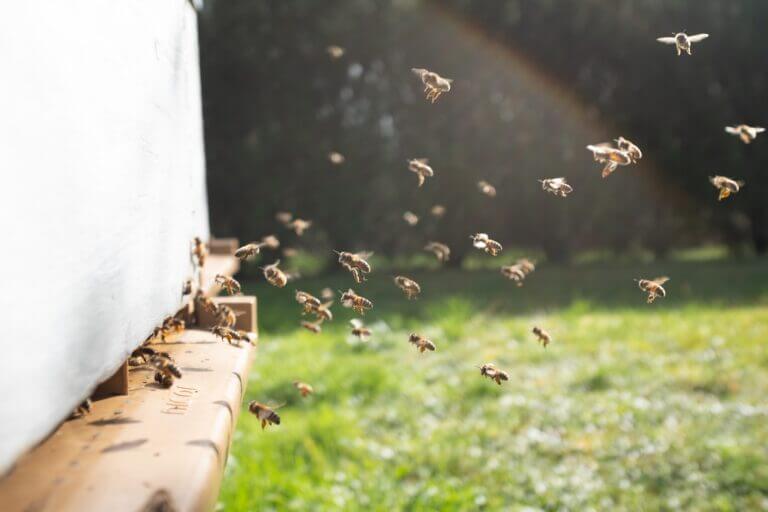It’s a common experience on a warm summer day. You’re out in the garden or taking a stroll, and suddenly you notice bees buzzing around you. A bee lands on your arm, and another hovers near your head. You wave them away, but the bees keep following you. Why does this happen, and what can you do about it? This article will explore the reasons bees are attracted to humans and provide tips on how to avoid being followed.
What Attracts Bees to Humans?
To understand why bees follow humans, we first need to look at what attracts them in general. Bees rely heavily on their sense of smell to locate food sources. They are attracted to sweet smells, especially floral scents, fruity aromas, and sugary foods. If you are wearing perfume, scented lotion, or sunscreen with a sweet fragrance, this can mimic the smell of flowers and draw bees to you. Even shampoos and soaps with added floral essences can attract bee attention. Bees also zero in on actual sugary substances, so eating ice cream, candy, or other treats outdoors is a sure way to invite a bee entourage.
In addition to smell, bees also use sight to locate resources. They are attracted to bright colors, especially blue, yellow, and purple. White clothing can also attract bees, as they mistake it for flowers. Wearing floral prints, bright jewelry, or accessories with shiny embellishments can make you a bee magnet. Bees also notice movement and are drawn to anything in motion. Swatting at bees or making sudden movements will only bring more around to investigate.
If you’ve been gardening or are near a field of wildflowers, bees may mistake you for a large flower. The faint fragrances from leaves and soil that cling to clothing and hair can be enough to confuse their senses. Bees gathering pollen and nectar from blossoms will naturally be attracted to a human that smells and looks like an enormous bloom.
Bee Behavior Around Hives and Flowers

Another common reason bees follow humans is their proximity to bee colonies and flowering plants. Honey bees have an approximately 3-mile foraging range from their hive, and bumblebees can travel over a mile from their nest. If you are within this zone of an active bee colony or a large flower field, the bees will be highly focused on gathering resources. When you are near their food sources, bees looking to collect nectar and pollen will zero in on any likely flower—including people that resemble them. The bees are simply mistaking you for a useful food source or resting spot in their habitat.
Spring and summer are peak bee foraging seasons, so you’re more likely to encounter bees near blooming gardens, orchards, parks, meadows, and other flower-filled places. Beekeeping has also grown in popularity, so hives may be located close to suburban neighborhoods. The bees are just doing their job, following scents and colors to locations that have reliably provided nectar and pollen in the past. You may get swept up in their pollen-gathering mission without them actively seeking you out.
Tips to Prevent Bees From Following You
Now that you know some reasons bees are attracted to humans, here are some tips to prevent them from trailing you:
Avoid heavily scented products
Switch out perfumed soaps, perfumes, hair products, and lotions for unscented versions. Use laundry detergents without added fabric softeners or floral scents. Minimize use of sugary skin products like body scrubs. Also consider avoiding strongly scented sunscreen, since you need to reapply this throughout the day.
Wear neutral colors when outside
Opt for clothing and accessories in white, tan, gray and other subtle shades. Avoid floral prints and go easy on jewelry. Tuck in brightly colored shirts, tie back long hair, and cover feet instead of bright sandals if bees are an issue. Minimize blue since it strongly attracts bees.
Stay away from known bee zones
Check your location for nearby apiaries and wildflower meadows. Avoid picnics and outdoor activities adjacent to these areas or times when bees are busiest like mid-day when flowers bloom. Move indoors or away from bee flight paths when you notice them passing by.
Avoid eating/drinking outdoors
Bees will detect any sugars or sweet scents and investigate. Have meals and snacks indoors or in screened rooms away from foraging zones. Avoid perfumes, sweet drinks, ice cream and fruity or sugary foods outside. Always check cans and bottles for bees before drinking.
Remain calm and still if bees approach
Bees are much less aggressive when humans are motionless, so freeze if they fly near you. Do not flap arms or swat. Quick motions will anger them. Just slowly move away from the area. Running or jumping with provoke stings.
Cover drink cans and straws
If you do eat/drink outside, use cups with lids and cover straw openings when not sipping. Check cans and bottles before each sip for any investigating bees. Keep food covered when not serving it.
Carry an umbrella
Take a small umbrella with a neutral colored fabric (not black, which absorbs heat). Open it for shade if bees start circling, so you appear like a flower. The umbrella creates a barrier and hides sweet scents rising from your person.
Bring a vial of lemongrass oil
Lemongrass and other essential oils repel bees naturally. Dab a bit on your wrists or cotton balls. You can also put lemongrass in water bottles. The smell discourages bees from investigating you and your food.
Check seat cushions and umbrellas
Bees often nest under outdoor chair cushions, so check before sitting. Peeking under umbrellas and beach covers prevents disturbing a sheltered swarm. Being cautious allows you to dodge bees who are just protecting their home.
Install water sources away from gathering spots
Bees need to hydrate like any creature. Put out a water tray, bird bath, or fountain away from patios, play areas, or gardens where you spend time outdoors. Give them an unobtrusive watering hole away from humans.
Remain calm around bee stings
If stung, calmly move away and apply ice. Do not dramatically wave or swat the area, which releases “alarm” scents that call more bees. Use sting removal kits to get the stinger out.
Know your emergency options
Carry allergy or sting medication if you have severe reactions. Tell companions you are allergic so they can respond. Know if you develop life-threatening symptoms from bee venom. Educate those around you about emergency care.
Plant bee-friendly flowers
Gardens, pots, and flower boxes with bee-attracting blossoms give them an appealing place to get nectar and move on. Target plants to draw them away from human hangouts. Native plants work best to provide an inviting bee buffet.
Why You Should Not Fear Bees
While being followed by bees can be alarming at first, there are good reasons not to panic. For one, honey bees will rarely sting humans unless extremely provoked or caught in clothing. Their stingers are actually modified egg-laying devices, so stinging pulls the stinger out of their body, causing death. Since they will die after stinging, it’s an absolute last resort for honey bees to defend themselves.
Bumblebees can sting repeatedly without injury but tend to be quite docile. Male bees and robber flies (which look like large bees) cannot even sting at all. Unless you swat at these insects or grab them, most will investigate then peacefully move on when they realize you are not a flower. You can safely observe flower visitors while taking steps to be less enticing.
Beyond that, bees are extremely important pollinators we depend on for much of our food supply. Their services are responsible for nearly $20 billion per year in U.S. agricultural production. Learning to coexist safely with bees helps protect these vital pollinators at a time when many species are declining. With some smart precautions, you can still enjoy the outdoors when bees are active.
Conclusion
Being followed by a train of bees can be disconcerting when you are just trying to enjoy the outdoors on a nice day. However, in most cases bees are simply mistaking humans for the flowers they rely on. With our sweet fragrances, colorful clothes, and proximity to their hives and blooms, we accidentally trick bees into thinking we are giant flowers. A few precautions like toning down scents, wearing neutral clothing, and remaining calm can prevent bees from shadowing you. Taking time to understand why bees follow humans allows us to appreciate the vital role of these pollinators in the environment. Next time bees start to swarm, you will know why they are attracted to you and how to gently dissuade them.






